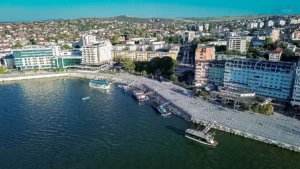
Little egret (Garzetta)
The Little Egret is a social bird that nests in mixed colonies with other waterfowl species. The nest is built of branches and reeds, usually in hard-to-reach areas such as trees or bushes in the middle of the water. The species is partly migratory, with northern populations migrating southwards in winter.
Egretta garzetta
Description and how to observe Little egret (Garzetta):
The Little Egret is an elegant bird with predominantly white plumage, which gives it a distinctive appearance. Its beak is black and its legs are black with yellow toes. To spot it, look out for wetlands in the Danube Delta, such as reedbeds, lakes and canals. The little egret is often seen sitting on one leg with its neck outstretched waiting for prey.
What it feeds on Little egret (Garzetta):
The little egret's diet consists mainly of small fish, amphibians, insects and crustaceans. To find food, the bird sits motionless in the water with its beak pointing downwards and waits for prey to approach.
Threats:
The main threats to the little egret include:
- Habitat destruction: Wetland drainage, pollution and urban development are reducing the areas available for nesting and feeding.
- Illegal hunting: In the past, egrets were hunted for their ornamental feathers, which were used to make hats.
- Nesting disturbance: Human activities near nesting colonies can cause birds to abandon their nests.
Ecological role:
Little egrets play an important role in the ecosystem, helping to maintain the balance of populations of fish and other aquatic organisms.
Read more about Egretta garzetta:
- Conservation status: The little egret is not currently considered a globally threatened species, but local populations may be affected by the factors mentioned above.
- Protection: The species is protected under national and international law, and the Danube Delta is an important refuge for the little egret.
- Comment: To see the little egret in its natural habitat, it's best to go on organised trips in the Danube Delta with an experienced guide.
Discover now the most beautiful places in the Danube Delta!
In the following pages, you will find detailed information about:
- Top tourist destinations: Traditional villages, nature reserves, tourist trails and much more.
- Activities and attractions: Everything you need to know about boating, fishing, bird watching, cycling and other activities.
- Accommodation and catering: Accommodation to suit all budgets and restaurants serving traditional cuisine.




